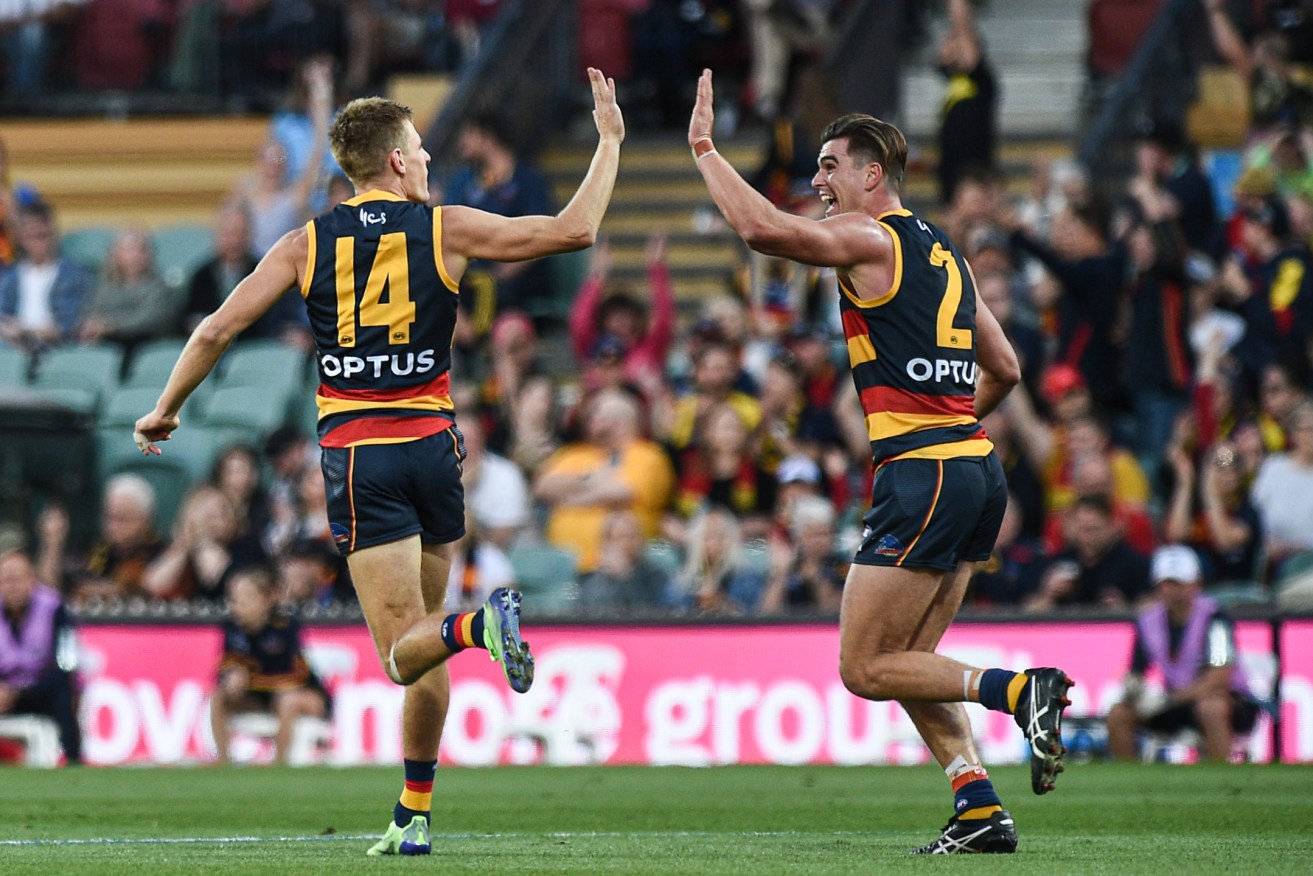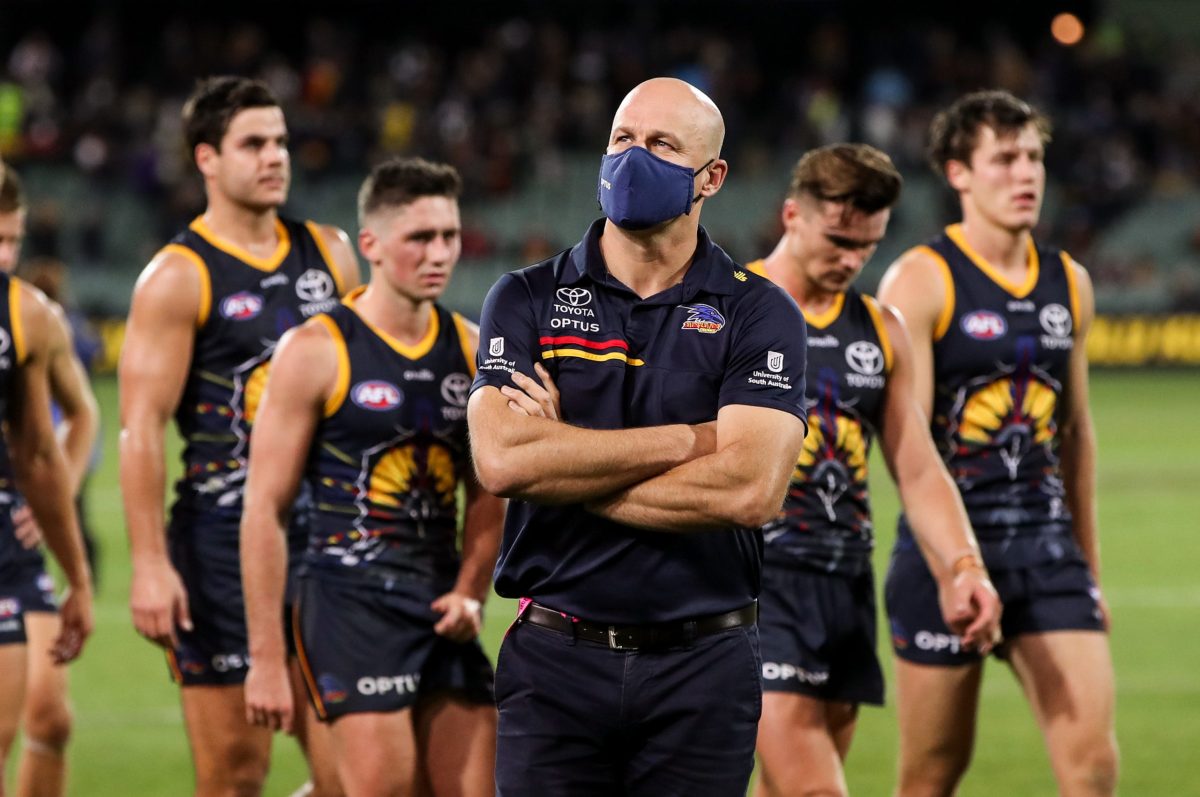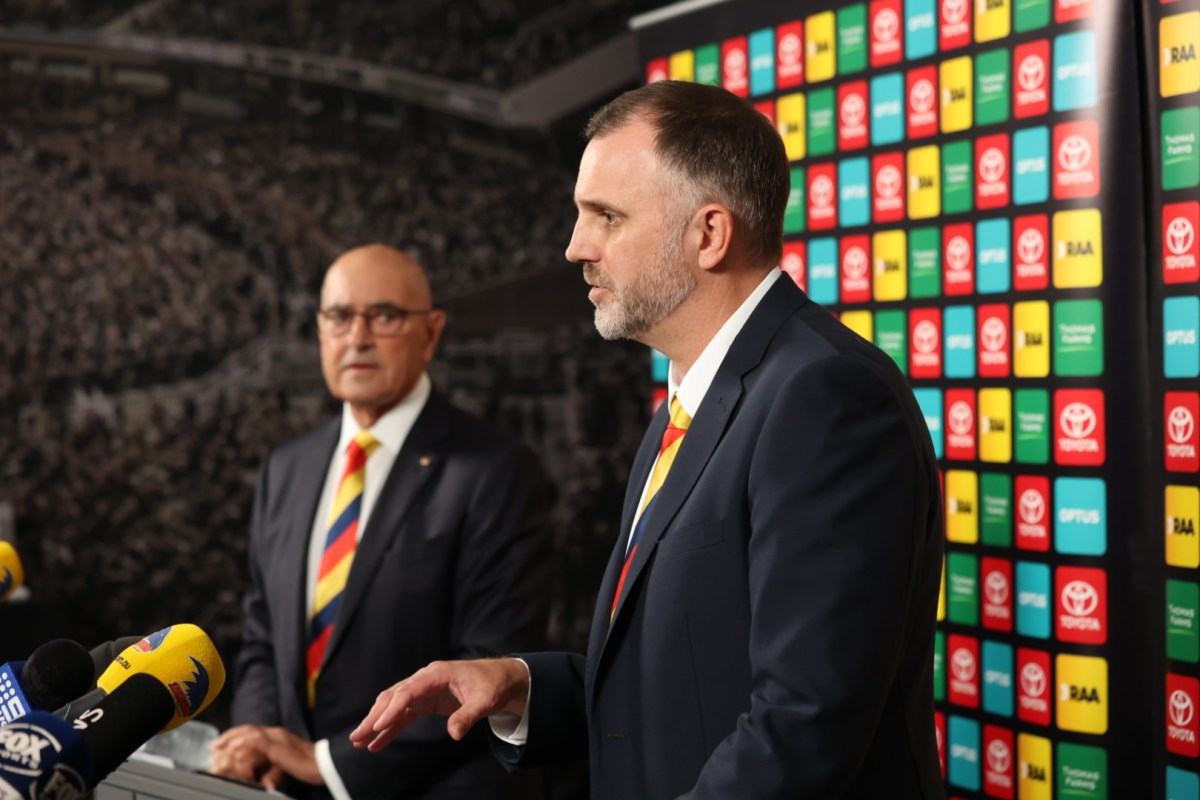Mid-season stocktake for Crows rebuild
Where is the Adelaide Football Club placed, on and off-field, in the rebuild many still say should have never unfolded at the state’s biggest sporting club? Michelangelo Rucci spoke to those in the know.

Photo: Michael Errey/InDaily
“It’s the worst Crows team we’ve seen in 31 years.”
Kane Cornes, the Port Adelaide AFL premiership hero turned multi-media football analyst, rarely leaves room for any misinterpretation in his commentary. And he went early, after Adelaide was thumped in consecutive weeks by a combined margin of 123 points by rival Port Adelaide at Alberton and Noarlunga during the shortened pre-season late in the recent summer.
Very small sample, as the late Phil Walsh would say, of conclusions drawn from as few as two matches, and pre-season games at that.
Three months later, with 12 meaningful home-and-away games on the AFL scoreboard, Cornes is shifting ground – but not by much.
“If it is not the worst,” Cornes told InDaily, “it is the second worst.”
Cornes dismisses Season 2020 – the COVID-shortened campaign in which Adelaide collected its only AFL wooden spoon while enduring a club-record 13-game losing streak from the opening bounce – from the debate.
“The club’s worst season in a 22-game home-and-away series is 2011; seven wins and 14th spot (in a 17-team league),” says Cornes of the year that cost coach Neil Craig his job after a decade as senior coach.
“Maybe my comment in March was at an extreme … but if it not the worst Crows team in 31 years, it will be the second-worst.”
Adelaide is stuck in the AFL’s dreaded bottom four today in 15th position of 18 national league teams, with four wins from 12 matches. Two of those victories have been against AFL pacesetters, league leader Melbourne and 2020 grand finalist Geelong. Two of the losses have been against teams ranked deeper in the bottom four, Collingwood and Hawthorn.
Analysts using Champion Data statistics and form lines predict Adelaide will remain in 15th spot, finishing the year with an 8-14 win-loss count. Cornes’ point will be made.
But where is the Adelaide Football Club in the bigger picture of its unexpected rebuild, both on and off the field?
Mid-season reviews generally work from the scoreboard and the statistical data that has overwhelmed top-end Australian football. But any meaningful review of Adelaide today would demand more searching analysis of the team and the club.
At the halfway mark of the AFL home-and-away season, InDaily spoke to those inside and outside the Crows clubhouse to assess just where South Australia’s biggest sporting club is on the road map to becoming an AFL leader on and off the field.
“I am impressed,” says Cornes. “They are on the right track.”
Stephen Rowe is an inaugural Crow, playing 29 AFL matches from 1991 to 1995. Today, he is a leading media commentator and has his son James in the Adelaide line-up, the first father-son pairing at West Lakes.
“In short,” says Rowe, “they are playing better football. They are more competitive, playing a better brand.”
Bill Sanders was Adelaide’s inaugural chief executive from 1991 and later club chairman. “There has been some improvement; there are encouraging signs,” he says.
Daniel Talia is the luckless All-Australian key defender who has spent all season on the sidelines by recurring injuries. His observation of his team-mates: “We’re certainly going a lot better than last year.”
“Rebuilds can be really tough, more so when you can’t train together as a full squad (by the COVID protocols that were in place at the start of last season when Nicks had to impart a new gameplan with a new squad while training was restricted to no more than eight players in a group).”
Former State premier John Olsen is in his first of an anticipated four years as Crows chairman. He has a very deliberate intent to observe before acting in his first 12 months.
“If you want to read a sign post of where we are on this road to a rebuild, it would say there is real change and renewed enthusiasm and optimism in this football club,” Olsen said.
“But we need patience,” adds the leader more inclined to evolution rather than revolution at West Lakes. “And there will be mistakes.”

Coach Matthew Nicks and players after the Round 12 loss to Collingwood at home. Photo: AAP/Matt Turner
Reviewing the Adelaide Football Club – a theme that has become a regular concept inside and outside the empire – would deliver optimism on many fronts and a major challenge in the critical task of building a regular AFL finalist and ultimately a premiership contender.
There has been genuine progress made in many key areas, but the jury is still out on the critical list-management work of Justin Reid and recruiting manager Hamish Ogilvie.
Adelaide cannot afford to get this wrong or it will become tagged the “new Carlton”, the Melbourne-based AFL rival that has rolled from one rebuild to another without success for 20 years.
Olsen is circumspect in answering where Adelaide is with list management.
“It is critical,” he says. “Our assessment is ongoing. And the decisions we make will have significant consequences, not just for next year but for many years.
“Our No.1 goal is a football focus,” adds Olsen, emphasising he will not underestimate the importance of the “ongoing” review of list-management decisions.
In this space, every external critic notes Adelaide has to develop a serious agenda. Mistakes could set a rebuild back five years.
Cornes says: “If you want an image of how bad list-management decisions kill you, just looked at Carlton and St Kilda today.”
Adelaide’s needs are increasingly clear.
“We’re light on. We need more experience and more polish,” says Sanders. “If you bracket your player squad in classes of A-grade, Bs and Cs, we need more As. We need more As.
“The system allows you to draft and develop those As. But that takes time, a long time.
“Or you trade for them. We have not done that for a long time,” adds Sanders who famously engineered the super trade that delivered premiership master Darren Jarman from Hawthorn in 1995. “I am not sure we have much we can trade to get those A-grade players today.”
By AFL rankings, there are just two Adelaide players with top-10 gradings – midfielder Rory Laird at No.6 for average disposals (31.17) and Taylor Walker at No.2 for goals (36). Neither, regardless of contract status, should become trade bait if the Crows want to build a new, lasting culture built on loyalty in the changerooms.
Rowe warns against investing all hope in the AFL national draft.
“It is too hit-and-miss,” says Rowe. “The team’s No.1 need is midfielders. Right now, I would target Brandan Parfitt from Geelong. He is a local lad (North Adelaide via the Northern Territory). He is 23. He will be an elite midfielder. Go for him at 100 miles per hour.
“If I was the list manager, it would be get two midfielders in the draft and two from other clubs.”
Cornes notes the concerning sign with Adelaide’s list is the lack of quick development of young talent, a more-imposing task while AFL clubs work to smaller budgets to cover financial losses from the COVID era.
“The improvement this year is from senior players, mainly those aged 28 and older – (former captain) Taylor Walker, Rory Laird, Paul Seedsman and (captain) Rory Sloane have improved and Adelaide has won games off their improved work,” says Cornes. “That is concerning because it we are not seeing the same from the next generation players such as Chayce Jones, Ned McHenry, Shane McAdam, Darcy Fogarty … or (Greater Western Sydney recruit) Jackson Hateley. Hateley has given them nothing.”
Adelaide’s richest draft cache last year coincided with the inability to assess talent from the critical Victorian metropolitan zones that were shutdown with COVID. The Crows focused on South Australian talent. Four of the club’s five picks were assigned to South Australians – Riley Thilthorpe (West Adelaide, No.2); Luke Pedlar (Glenelg, 11); Brayden Cook (South Adelaide, 25); Sam Berry (Gippsland, 28); and James Rowe (Woodville-West Torrens, 38).
Was such a heavy emphasis on South Australians prompted by the pressing need to end the so-called exodus from West Lakes, knowing there is no “go-home” risk with local talent?
“If you want to lock yourself into predominantly drafting South Australians,” warns Cornes, “you will deny yourself the best talent.”
Adelaide’s retention of players – a sore point that prompted senior coach Matthew Nicks to take to the microphone to quell discontent at the members’ meeting at Adelaide Oval in March – has a new image today with the resignings of 13 players in the first half of the year, in particular “future captain” Tom Doedee.
Culturally, the clubhouse has significantly changed under Nicks’ watch – a point keenly observed by Olsen and emphasised by Talia.
“I have been impressed by the clear focus Matthew Nicks has had on building a culture for the players and our club,” Olsen said. “We have an enthusiastic squad today. When you get a senior player with vast experience saying last year felt like ‘going to work’ whereas this year it is ‘enjoyable to come to training’ you know we have moved on from last season’s issues.
“Where there was a lack of intensity and resolve there is now determination to get better. There are good signs for next year and beyond.”
Talia adds: “We have shown our best footy can match it with the best … but we have to be more consistent to take the next step.
“Our fans would have to be happy with how the guys are competing.
“We need to put more work into our skills, that has let us down at times along with our finishing in front of goal.
“We do need to add skill and depth through coming drafts. And for all areas of he ground. That is up to list management to do that. As a club, there is a really good feel after we have made a lot of changes.”
Where has Adelaide changed, on and off the field?
Nicks is working to a new coaching staff; Scott Burns from Hawthorn as senior assistant and defence coach; former captain Nathan van Berlo from West Coast as midfield coach and the understated James Rahilly from Geelong as forwards coach.
“You can see the gameplan building with this coaching group,” says Rowe. “Unfortunately, they don’t have enough elite players to play that plan for four quarters.”
The significant note here is Adelaide has lost each of its 12 third quarters this season. The fall-off after half-time is telling of the squad Nicks is developing.
“That (third-quarter issue) falls on the players,” Cornes said.
Olsen now has a new chief executive, former Hawthorn chief operating officer Tim Silvers, who replaced the increasingly unpopular Andrew Fagan in March.

John Olsen and Tim Silvers. Photo: Tony Lewis / InDaily
Silvers has made a “soft” opening with minimal media attention, but there is no question internally he has changed the tone within a front office that was loaded with discontent among the staff.
“Tim is a very good fit for our club,” Olsen said. “His experience in an AFL club such as Hawthorn, from the commercial department to the football department and the chief executive’s chair has built a background of wisdom and huge knowledge.”
Off field, Adelaide’s big agenda item is finding a new administrative and training base away from West Lakes. Gone is the dream of a base in the city. It is now either Thebarton Oval in a share arrangement with the SANFL and Adelaide Footy League or the old gas works depot at Brompton.
Olsen told InDaily the original hope of a decision in June is gone, with a new date aligned to a board meeting in early September.
“We have done 90 per cent of the (due diligence and planning) work on Thebarton Oval, but we have to consider using a school oval while the work on the South Road tunnels takes out Kings Reserve as a second training ground (for use as a depot for tunnelling equipment for as many as eight years and ultimately could leave a permanent six or eight-metre wall on the oval),” Olsen said.
“And Brompton involves the cost of soil remediation, but not to the extent demanded of residential housing estates. We still have some work to do.”
Another off-field agenda is appeasing an agitated and bruised fan base. Signals from AFL House project intown rival Port Adelaide will have more members than Adelaide for just the second time since the local market carried two AFL clubs in 1997.
“We have made a concerted effort to connect with our fans with more ‘inner sanctum’ access,” Olsen said, pointing to league-best figures in fan engagement across social media in February.
But wins on the field do more than jazzy videos on Facebook and Twitter.
“We had members walk away when there were seating changes with reduced capacity at Adelaide Oval, saying it was all too hard,” Olsen said. “And we gained members on the back of wins against Melbourne and Geelong.”
Adelaide certainly has changed its image with off-field mistakes, such as the botched up use of injured forward Tom Lynch as a medical substitute against Hawthorn in Launceston and the failure of five players and three staff to wear masks on the flight back from Sydney after losing to AFL premier Richmond.
“When we don’t get it right, we front up and cop it sweet,” Olsen said of the shift in a club media department that became known as “spin city”.
So where is Adelaide on this long road called the “rebuild”?
“A rebuild needs patience while you build experience,” says Olsen. “My view is we are on track. We have real talent with (No.2 draftee) Riley Thilthorpe and (21-year-old defender) Jordan Butts.
“We have begun to make real change.”




